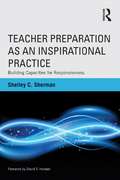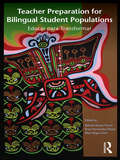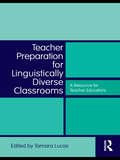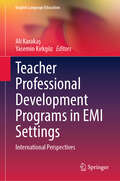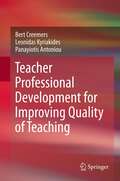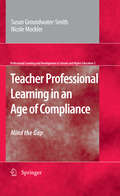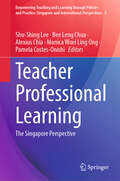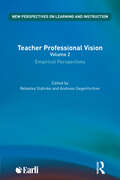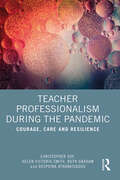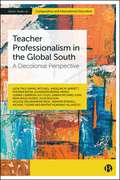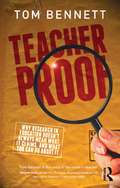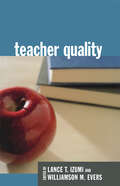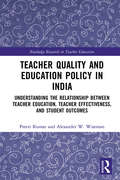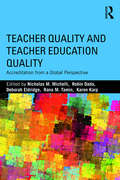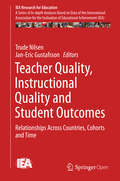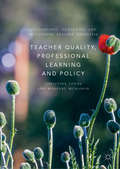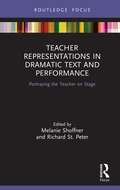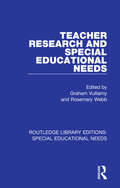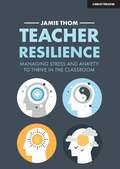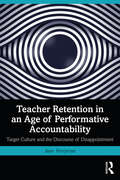- Table View
- List View
Teacher Preparation as an Inspirational Practice: Building Capacities for Responsiveness
by Shelley ShermanHow can teacher educators provide prospective teachers with a philosophical foundation for dimensions of teaching associated with responsiveness to students? How can they help focus teacher candidates, during their through coursework and, especially, during clinical experiences, on developing their capacity to be responsive to students as unique human beings? Drawing from the literature base on teaching’s moral dimensions, this book establishes a conceptual framework for responsiveness, describes obstacles to its actualization, and suggests approaches for nurturing responsive capacities in teacher candidates. Voices of teacher candidates and teacher educators animate the conversation about responsiveness . Philosophy and practice are situated within the context of tensions between standardization and teachers’ commitments to remain true to the unique needs of students. The book provides multiple entry points for approaching the topic of responsiveness, including scholarly literature, qualitative data analysis, the author’s personal voice as a teacher educator, and the voices of other teacher educators and of teacher candidates discussing personal experiences, including successes and challenges within clinical experiences. Philosophy and practice are intertwined and practice-based interventions are suggested.
Teacher Preparation for Bilingual Student Populations: Educar para Transformar
by Belinda Bustos FloresThe growing number of bilingual students in public schools coupled with a critical shortage of teachers specially prepared to serve this population calls for a critical examination of policies and practices in bilingual and ESL teacher preparation. This volume focuses on understanding the structural, substantive, and contextual elements of preparation programs, and provides transformative guidelines for creating Educar signature programs. Designed to improve the practice of teacher preparation by promoting dialogic conversations and applications of praxis in the preparation of bilingual/ESL teacher candidates, it emphasizes that exemplary teacher preparation requires transformative teacher educators. Simultaneously organizing the scholarship in the field and advancing new understandings, this book is must-have resource for current and future teacher educators. Contributors include Maria Brisk, Sylvia Celédon-Pattichis, Lourdes Diaz-Soto, Eugene García, Virginia Gonzáles, Guillermo Solano-Flores, Maria Torres-Guzman, Carmen Mercado, Bertha Pérez, Mari Riojas-Cortez, Francisco Rios, Concepción Valadez, and Angela Valenzuela.
Teacher Preparation for Linguistically Diverse Classrooms: A Resource for Teacher Educators
by Tamara LucasTeacher educators today need knowledge and practical ideas about how to prepare all pre-service and in-service teachers (not just bilingual or ESL specialists) to teach the growing number of students in K-12 classrooms in the United States who speak native languages other than English. This book is at the forefront in focusing exclusively on the preparation of mainstream classroom teachers for this population of students. Part one provides the conceptual and contextual framework for the book, including a comprehensive discussion of relevant demographic trends and an analysis of national and state policies. Part two presents examples of initiatives in different institutional and geographic settings, highlighting three essential elements of teacher preparation: curriculum content, program design, and program coherence. Meeting a pressing need among teacher educators left to figure out, largely by trial and error, how best to prepare non-specialist classroom teachers to work with ELLs, this book both contributes to the research base and provides practical information to help readers envision possibilities they can apply in their own settings.
Teacher Professional Development Programs in EMI Settings: International Perspectives (English Language Education #42)
by Yasemin Kırkgöz Ali KarakaşThis book showcases a range of professional development activities in English medium instruction (EMI) from diverse international contexts. While EMI offers many benefits, it also comes with challenges for both teachers and learners, especially in terms of language proficiency, teaching practices, and curriculum design. To address these challenges, professional development activities are essential for supporting teachers and learners in EMI contexts. The scope of the book includes topics such as teacher training, curriculum design, assessment, classroom practices, and policy implementation in a range of EMI settings, including higher education, schools, and vocational institutions. The book offers practical guidance and innovative approaches for practitioners that will enhance their teaching practices and support their learners. The book also provides new insights into the challenges and opportunities of EMI in different contexts and contributes to the development of new theoretical frameworks for understanding EMI. This book is intended for EMI teachers, teacher trainers, researchers, policymakers, and administrators at different levels of education.
Teacher Professional Development for Improving Quality of Teaching
by Bert Creemers Leonidas Kyriakides Panayiotis AntoniouThis book makes a major contribution to knowledge and theory by drawing implications of teacher effectiveness research for the field of teacher training and professional development. The first part of the book provides a critical review of research on teacher training and professional development and illustrates the limitations of the main approaches to teacher development such as the competence-based and the holistic approach. A dynamic perspective to policy and practice in teacher training and professional development is advocated. The second part of the book provides a critical review of research on teacher effectiveness. The main phases of this field of research are analysed. It is pointed out that teacher factors are presented as being in opposition to one another. An integrated approach in defining quality of teaching is adopted. The importance of taking into account findings of studies investigating differential teacher effectiveness is argued. Another significant limitation of this field of research is that the whole process of searching for teacher effectiveness factor was not able to have a significant impact upon teacher training and professional development. For this reason it is advocated that teacher training and professional development should be focused on how to address grouping of specific teacher factors associated with student learning and on how to help teachers improve their teaching skills by moving from using skills associated with direct teaching only to more advanced skills concerned with new teaching approaches and differentiation of teaching. The book refers to studies conducted in different countries illustrating how the proposed approach can be used by policy and practice in teacher education. Specifically, the book provides evidence supporting the validity of the theoretical framework upon which this approach is based. Moreover, experimental and longitudinal studies supporting the use of this approach for improvement purposes are presented and suggestions for further research utilising and expanding the Dynamic Approach for teacher training and professional development are provided.
Teacher Professional Knowledge and Development for Reflective and Inclusive Practices (Routledge Research in Education)
by Nena Padilla-Valdez Ismail AmzatThis book brings together the practice of reflective teaching and the knowledge of inclusive practices in the context of teacher education and continuing professional development. It is a call to leverage reflective teaching for inclusive practices. The first part of the book provides an overview of what constitutes reflective practice in the 21st century and how teachers can become reflective practitioners. It also discusses how teacher professional development can be enhanced for reflective teaching practice. The second part of the book deals with teachers' knowledge development in order to create inclusive teaching and learning environments. It highlights the need for a responsive teaching climate, intercultural competency, pedagogical change and professional literacy. A reflective inclusive teacher is likely to anticipate the multiple needs of diverse learners in pluralistic settings, thus ensuring student success. This book will enhance the efforts of teacher educators and teaching professionals in building a culture of reflective and inclusive teaching practice in the classroom.
Teacher Professional Learning in an Age of Compliance
by Susan Groundwater-Smith Nicole MocklerTeacher Professional Learning in an Age of Compliance: Mind the Gap examines ways in which practice-based inquiry in educational settings, in a number of different countries and contexts, can transcend current ways of working and thinking such that authentic professional learning is the result. The authors contend that education policy, under pressure from a number of quarters, is retreating into a standardized, audited, and backward-looking arena, with the advances of more progressive educational philosophy being rolled back. In an age where practitioner inquiry and action research have often been 'hijacked' for the purposes of broad-based policy implementation, this book offers a rationale for reclaiming the critical edge so fundamental to inquiry-based professional learning. It examines the potential of inquiry-based forms of teacher professional learning to contribute to the growth of professional knowledge for and about teachers' work. The authors intend that the book will assist in building new forms of professional knowledge that go beyond the current compliance model - engineered from less enduring materials - to inform a new model with its foundations in a strong ethical and moral framework. They also believe that this new model, if implemented, will help to reverse today's conservative educational trends and make teacher professional development a force for genuine progress once again. They have consciously moved away from the celebratory tone of much of the academic reporting of teacher professional learning, adopting instead a genuinely critical edge. In covering a wide range of policies and practices from across the international spectrum, they have allowed themselves the freedom to engage in serious epistemological arguments about the nature of professional knowledge, as well as how it is constructed and employed.
Teacher Professional Learning through Lesson Study in Virtual and Hybrid Environments: Opportunities, Challenges, and Future Directions (WALS-Routledge Lesson Study Series)
by Heng Jiang Rongjin Huang Nina Helgevold Jean LangOffering a rich, critical investigation of how technology can be used to strengthen and promote lesson study in both virtual and hybrid environments, this edited book presents insights into the numerous challenges as well as opportunities for supporting teachers’ and teacher educators’ professional learning in such a novel setting. Providing an international perspective, research in this book highlights on the one hand the necessity of exploring how the known theoretical perspectives and methodological approaches for researching on lesson study and effective characteristics of conducting lesson study can be adapted to the new environments. On the other hand, further analysis reveals the benefits of using various advanced technologies in lesson study, the new practice of professional development of teachers and teacher educators, and also documents related issues of conducting lesson study in such complex contexts. The chapters focus on online cross-cultural lesson study; the key aspects of conducting online lesson study and the effectiveness of it. Features of facilitation and the development of facilitators for online lesson study are explored, alongside the ways in which online lesson study can help address various problems of practice such as implementing equitable teaching, facilitating student interaction in virtual environments, and migration to remote teaching in STEM. This resourceful text provides needed support to both researchers and practitioners, from primary to higher education, with special attention to both teacher and student learning.
Teacher Professional Learning: The Singapore Perspective (Empowering Teaching and Learning through Policies and Practice: Singapore and International Perspectives #3)
by Shu-Shing Lee Pamela Costes-Onishi Bee Leng Chua Alexius Chia Monica Woei Ling OngThis book provides an insider&’s perspective of the Singapore education system that views teacher capacity building as a key lever for quality educational experiences. It describes experiences from policy conceptualisation to practice implementations of teacher learning. This book includes international perspectives in the form of expert commentaries and critique where comparisons are made between Singapore&’s experiences and those of other education systems. It also describes the complexities of teacher professional learning within and across three levels: policies, partnerships, and schools, that shape policy to practice implementations of teacher professional learning from pre-service to in-service teachers. Together with the international scholars, this book shares the lessons learnt in Singapore to encourage policy makers, scholars, and schools to continue thinking about how teacher professional learning can be enhanced, caution against the direct transfer of practices, and describe how teacher capacity building lays the foundation for the education system to stay relevant, address challenges, and meet students&’ needs.
Teacher Professional Vision: Empirical Perspectives (New Perspectives on Learning and Instruction)
by Andreas Gegenfurtner Rebekka StahnkeResearch has shown that although teachers’ knowledge about the subject or pedagogy is important, a teacher’s professional vision (including their perceptions and pedagogical decisions) can also have a significant impact on the efficacy of their practice.Firmly grounded in the long-standing field of teacher professional vision research, this two-volume edited book explores new theoretical models, emerging methods, and empirical findings, highlighting areas to explore within future research and insights into the design of teacher education and teacher professional development.Volume 2 of this book, Teacher Professional Vision: Empirical Perspectives, provides insights into research on teacher professional vision across different domains, including aspects of equity, classroom management, and subject teaching. Perspectives of different subject areas and school levels (from elementary school to higher education) are explored throughout.Written by a diverse team of leading experts in the field, this volume and its companion volume cover theoretical and methodological advances in teacher professional vision. This is an essential resource for researchers and professionals in the field of teacher education and professional development.
Teacher Professional Vision: Theoretical and Methodological Advances (New Perspectives on Learning and Instruction)
by Andreas Gegenfurtner Rebekka StahnkeResearch has shown that although teachers’ knowledge about the subject or pedagogy is important, a teacher’s professional vision (including their perceptions and pedagogical decisions) can also have a significant impact on the efficacy of their practice.Firmly grounded in the long-standing field of teacher professional vision research, this two-volume edited book explores new theoretical models, emerging methods, and empirical findings, highlighting areas to explore within future research and insights into the design of teacher education and teacher professional development.Volume 1 of this book, Teacher Professional Vision: Theoretical and Methodological Advances, examines cutting-edge international research on the theoretical models and methods used to study the crucial subject of teacher professional vision.Written by a diverse team of leading experts in the field, this volume and its companion volume cover theoretical and methodological advances in teacher professional vision. This is an essential resource for researchers and professionals in the field of teacher education and professional development.
Teacher Professionalism During the Pandemic: Courage, Care and Resilience
by Ruth Graham Christopher Day Helen Victoria Smith Despoina AthanasiadouThis insightful book uniquely charts the events, experiences and challenges faced by teachers during and beyond the COVID-19 pandemic including periods of national lockdowns and school closures. Research-based and evidence informed, this key title explores the multiple media outputs created by teachers in a variety of different socio-economic contexts. The authors reflect on their stories through a series of themed analyses, as well as describing and discussing key issues related to the enactment of teacher professionalism in challenging times. With fascinating vignettes and interview extracts that reinforce the idea that teachers can manage rather than survive, this book unveils a strong sense of moral purpose, professional identity, commitment, care and resilience. It will be of interest to teachers, head teachers and teacher educators internationally.
Teacher Professionalism in Further and Higher Education: Challenges to Culture and Practice
by Jocelyn RobsonTeachers from further and higher education are rarely considered together. This book explores the differences and similarities that exist between these groups. It provides an up-to-date account of developments and brings together arguments and debates about both groups of teachers to challenge some strongly held beliefs. Focusing on aspects of teachers' professionalism, Jocelyn Robson considers what 'professionalism' may mean and ways in which 'professionalism' has been studied. She goes on to consider: professional standards, training and qualifications professional identities and communities opportunities and strategies for professional development and renewal key debates in the literature and the most significant policy developments the main challenges currently facing the teaching profession in further and higher education.
Teacher Professionalism in the Global South: A Decolonial Perspective (Bristol Studies in Comparative and International Education)
by Jennifer Rowsell Alf Coles Julia Paulson Leon Tikly Poonam Batra Rafael Mitchell Angeline M. Barrett Alexandra Bernal Leanne Cameron Zawadi Richard Juma Nidia Aviles Nunez Nigusse Weldemariam Reda Michael Tusiime Beatriz VejaranoThis book provides a decolonial critique of dominant global agendas concerning teacher professionalism and proposes a new understanding based on UNESCO-funded research with teachers based in Colombia, Ethiopia (Tigray), India, Rwanda and Tanzania. Outlining from a teacher’s perspective how teacher professionalism may be conceptualized, this book critiques dominant global narratives and conceptions based on deficit discourses. The authors argue that a decolonial lens can help to contextualize the perspectives, experiences and material conditions of teachers in the global South, and the value of such a framework for informing global debates and decision-making in education.
Teacher Proof: Why research in education doesn’t always mean what it claims, and what you can do about it
by Tom Bennett‘Tom Bennett is the voice of the modern teacher.’ - Stephen Drew, Senior Vice-Principal, Passmores Academy, UK, featured on Channel 4’s Educating Essex Do the findings from educational science ever really improve the day-to-day practice of classroom teachers? Education is awash with theories about how pupils best learn and teachers best teach, most often propped up with the inevitable research that ‘proves’ the case in point. But what can teachers do to find the proof within the pudding, and how can this actually help them on wet Wednesday afternoon?. Drawing from a wide range of recent and popular education theories and strategies, Tom Bennett highlights how much of what we think we know in schools hasn’t been ‘proven’ in any meaningful sense at all. He inspires teachers to decide for themselves what good and bad education really is, empowering them as professionals and raising their confidence in the classroom and the staffroom alike. Readers are encouraged to question and reflect on issues such as: the most common ideas in modern education and where these ideas were born the crisis in research right now how research is commissioned and used by the people who make policy in the UK and beyond the provenance of education research: who instigates it, who writes it, and how to spot when a claim is based on evidence and when it isn’t the different way that data can be analysed what happens to the research conclusions once they escape the laboratory. Controversial, erudite and yet unremittingly entertaining, Tom includes practical suggestions for the classroom throughout. This book will be an ally to every teacher who’s been handed an instruction on a platter and been told, ‘the research proves it.’
Teacher Quality
by Lance T. Izumi Williamson F. EversIn this book some of the brightest minds in education research have studied pressing questions about teacher quality and practices, reviewed thousands of education studies, examined state test scores, explored education theories, and then affirmed that we know what works. We must now ensure that the system provides the best possible education for kids.
Teacher Quality and Education Policy in India: Understanding the Relationship Between Teacher Education, Teacher Effectiveness, and Student Outcomes (Routledge Research in Teacher Education)
by Alexander W. Wiseman Preeti KumarBy drawing on quantitative data and qualitative analyses of five major national education policies implemented in India over the last 15 years, this comprehensive volume explores their impact on teacher quality and perceived effectiveness, explaining how this relates to variations in student performance. Responding to a national agenda to increase the quality of the Indian teacher workforce, Teacher Quality and Education Policy in India critically questions the application of human capital theory to Indian education policy. Chapters provide in-depth and strategically structured analyses of five national policies – including the recently approved National Education Policy (NEP) 2020 – to see how Indian policymakers use teacher quality as a driver and measurement of education and national economic development. Ultimately, the text offers evidence-based policy recommendations to improve teacher quality in India, suggesting that while all five policies have contributed significant frameworks and recommendations for teacher quality reform, they have failed to move beyond a symbolic function. Given its rigorous methodological approach, this book will be a valuable addition to the under-researched question of education policymaking in postcolonial contexts. It will be an indispensable resource not only for scholars working on policymaking in the Indian context, but also for those working at the intersection of education, teacher development, and policymaking in developing countries.
Teacher Quality and Teacher Education Quality: Accreditation from a Global Perspective
by Karen Karp Nicholas M. Michelli Robin Dada Deborah Eldridge Rana M. TamimAccreditation of teacher education programs is increasingly embraced internationally and is being modeled after the American experience, despite criticisms from some in the field of teacher education in the United States. This book examines the transformation of accreditation and the interest and perception of nations and regions choosing to use the model in their own culture, including the Middle East and Gulf Region, South America, and the United Kingdom. Its distinctive edge is the juxtaposition of three sectors: quality assurance/accreditation, teacher preparation, and global/international experiences. The authors address how the adoption of a universal requirement for accreditation embraces a particular view of what teacher quality means. The emphasis on the development of teacher preparation in concert with accreditation is of academic interest to scholars in the United States and abroad. The experiences and voices of teacher educators as international colleagues in a global climate of accountability brings a fresh perspective on shared challenges.
Teacher Quality, Instructional Quality and Student Outcomes
by Trude Nilsen Jan-Eric GustafssonThis volume offers insights from modeling relations between teacher quality, instructional quality and student outcomes in mathematics across countries. The relations explored take the educational context, such as school climate, into account. The International Association for the Evaluation of Educational Achievement's Trends in Mathematics and Science Study (TIMSS) is the only international large-scale study possessing a design framework that enables investigation of relations between teachers, their teaching, and student outcomes in mathematics. TIMSS provides both student achievement data and contextual background data from schools, teachers, students and parents, for over 60 countries. This book makes a major contribution to the field of educational effectiveness, especially teaching effectiveness, where cross-cultural comparisons are scarce. For readers interested in teacher quality, instructional quality, and student achievement and motivation in mathematics, the comparisons across cultures, grades, and time are insightful and thought-provoking. For readers interested in methodology, the advanced analytical methods, combined with application of methods new to educational research, illustrate interesting novel directions in methodology and the secondary analysis of international large-scale assessment (ILSA).
Teacher Quality, Professional Learning and Policy: Recognising, Rewarding and Developing Teacher Expertise
by Christine Forde Margery McMahonThis book examines the significance of teacher expertise in the drive to improve quality and effectiveness. Scrutinising both key conceptual issues and current policy developments and approaches, the authors analyse educational systems from around the world and question how different cultural contexts and systems can implement measures to improve teacher effectiveness. The book analyses factors such as policy change and teacher evaluation as well as the regulation of the teaching profession to determine how these aspects can influence the expertise of individual teachers. As numerous policy interventions have tried to define and enhance teacher quality to raise pupil achievement, this book calls for an interrogation of this stance and signals a need to consider an alternative approach. This book will appeal to students and scholars of teacher effectiveness and professional learning, as well as researchers and policymakers.
Teacher Representations in Dramatic Text and Performance: Portraying the Teacher on Stage (Routledge Research in Teacher Education)
by Melanie Shoffner Richard St. PeterThis book examines representations of the teacher on stage - in both theatrical performances and dramatic text - in order to demonstrate how these representations have shaped society’s perceptions of educators in and out of the classroom. At the heart of this book is the interaction between theatre and teacher education. By considering how dramatic portrayals reimagine, reinforce and/or undermine our understanding of the teacher’s personal and professional roles, this volume bridges the gap between truth in dramatic literature and truth in the classroom. Chapters critically explore the personas embodied by fictional teachers in well-known works such as Educating Rita, School of Rock and The History Boys and illustrate how educators might use dramatic literature and performance to interrogate entrenched ideas about the student-teacher dynamic. By bringing together a diverse set of contributors from the fields of teacher education and theatre, this book takes a critical look at performance, text, society and culture to promote a new understanding of teaching and learning. This unique book will be of great interest to graduate and postgraduate students, academics and researchers in the fields of teacher education, drama and theatre education.
Teacher Research and Special Education Needs (Routledge Library Editions: Special Educational Needs #58)
by Rosemary Webb Graham VulliamyFirst published in 1992. This book provides accounts of case-study research and evaluation in the area of special educational needs carried out by teachers in ordinary and special schools. Contributors discuss their experiences of the problems and possibilities of teacher research and provide advice on information-gathering, analysis and writing up. The findings presented address both whole-school matters, such as the use of support staff in ordinary schools, and the development of an assessment policy in a special school, and a range of current issues, such as partnership with parents and the teaching of children with emotional and behavioural difficulties. It is of interest to all teachers and tutors involved in research-based courses, students in primary and secondary initial teacher training, teachers on in-service courses, support staff for special educational needs.
Teacher Resilience: Managing stress and anxiety to thrive in the classroom
by Jamie ThomTeaching is a wonderful profession, but it is one that requires huge amounts of physical, mental and psychological reserves. Inner resilience is a vital part of this, and the dialogue about how to develop it has been missing in conversations about teacher wellbeing. Resilience is ultimately the difference between being overwhelmed by stress and anxiety, to finding calm, purpose and joy in the work we do with young people. Teacher Resilience explores how we can build a more resilient mindset, and what practical actions we can take to be the best version of ourselves in the classroom. From self-talk to collaboration, conflict management to lesson planning and differentiation, no trigger of potential teacher stress and anxiety is left unexplored. With practical tools to implement immediately, this is the book that all teachers need to thrive in a demanding profession.
Teacher Resilience: Managing stress and anxiety to thrive in the classroom
by Jamie ThomTeaching is a wonderful profession, but it is one that requires huge amounts of physical, mental and psychological reserves. Inner resilience is a vital part of this, and the dialogue about how to develop it has been missing in conversations about teacher wellbeing. Resilience is ultimately the difference between being overwhelmed by stress and anxiety, to finding calm, purpose and joy in the work we do with young people. Teacher Resilience explores how we can build a more resilient mindset, and what practical actions we can take to be the best version of ourselves in the classroom. From self-talk to collaboration, conflict management to lesson planning and differentiation, no trigger of potential teacher stress and anxiety is left unexplored. With practical tools to implement immediately, this is the book that all teachers need to thrive in a demanding profession.
Teacher Retention in an Age of Performative Accountability: Target Culture and the Discourse of Disappointment
by Jane PerrymanIn this insightful and timely volume, Jane Perryman provides a definitive analysis of the crisis in teacher recruitment and retention through a critique of the culture of performative accountability in education, bringing together theory, literature, and empirical data. Drawing on data across several long-term research projects and through a Foucauldian theoretical framework, Perryman argues that teachers’ working lives, both in the UK and internationally, are being increasingly affected by the rise in the neoliberal performativity and accountability culture in schools. Teachers’ work is increasingly directed towards assessment, exams, progress measures, and preparation for review and inspection, and drawn away from the more individualistic and creative aspects of the job. This culture of hyper accountability and super-performativity, Perryman argues, has created a ‘discourse of disappointment’ – where the hopes and aspirations of teachers are crushed beneath the performative pressures under which they work. Teacher Retention in an Age of Performative Accountability offers a convincing, compellingly written critical analysis of how the values, purposes and practices embedded in education affect the working experience of teachers over time. Perryman makes a significant contribution to our understanding of the effects of accountability and performativity mechanisms in schools and offers insight into why so many teachers leave the profession. This analysis is important to scholars, educators, and policymakers alike.
